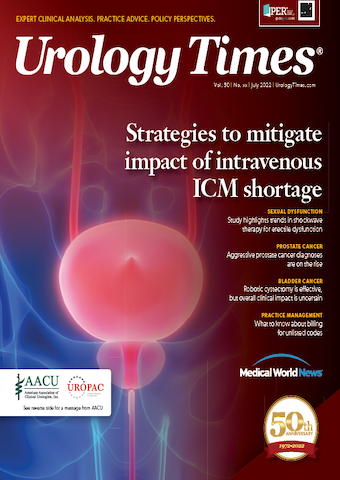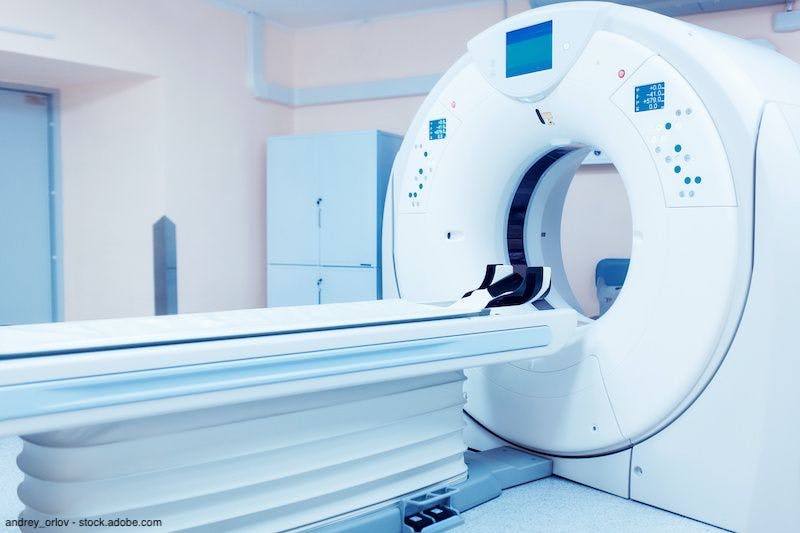Publication
Article
Urology Times Journal
Study characterizes trends in shock wave therapy for erectile dysfunction
Author(s):
Amid the growing direct-to-consumer market for shock wave therapy (SWT) as a treatment for erectile dysfunction (ED), a study published in Urology Practice assessed emerging trends for the treatment across 8 large US cities.1
The researchers identified 152 clinics across the cities that offered SWT as an ED treatment. Roughly two-thirds (65%) of the clinics had comprehensive information available on their SWT usage. Urologists made up only 25% of SWT providers at the clinics and 13% of the providers were not physicians.
Based on individual patient circumstance, therapy ranged from 1 treatment course to indefinite treatment courses at an average price of $3,338.28 for a full treatment course. The average cost of 1 individual session of a given SWT treatment course was $491.22.
“SWT, as a restorative therapy for ED, is performed primarily by non-urologists and is not standardized. Direct-to-consumer marketing is used to target distressed men. This study highlights concerning trends in major metropolitan markets, given the substantial financial impact for patients and inconsistent credentials among providers. Further, these findings suggest that patients are frequently seeking care for ED from non-urologists,” the study authors wrote.
The 8 US cities used for the study were Los Angeles, New York, Houston, Philadelphia, Atlanta, Boston, Dallas, and Washington, DC. Google was used to identify SWT providers in these metropolitan areas. The search terms used were, “Shockwave therapy for erectile dysfunction in [city];” “Shockwave therapy for ED in [city];” and “GAINSWave in [city].” To gather the data, the investigators implemented a “secret shopper” approach, whereby they called the clinics to collect provider, price, and treatment course information.
The researchers found that there was a lack of standardization across the clinics with regard to use of focused shock wave therapy (fSWT) vs acoustic or radial wave therapy (rWT), location of shock wave administration (eg, perineal, penile), and treatment protocol. Treatment courses consisted of a wide variety of session totals, with 6 being the most common. There was no consistency regarding the devices used for the procedure, the number of shocks during each session, or the energy and frequency settings.
There were 18 different provider types among the physicians offering SWT. The investigators specifically drew attention to the fact that the fourth most common provider type among physicians were those trained in obstetrics and gynecology. “These physicians see no male patients throughout the entirety of their training, including no formal instruction in the pathogenesis and treatment of male sexual dysfunction,” the authors wrote.
In almost half (n = 3) of the cities, SWT was offered by as many or more non-physician providers as it was offered by urologists. Non-physician SWT providers included physician assistants, nurse practitioners, chiropractors, and naturopathic providers.
There was high variation in the cost of SWT treatment courses, from a low of $600 for the set of sessions at one Atlanta clinic to a high of $16,200 at a New York City location.
In an accompanying editorial2 published simultaneously with the article, Jonathan N. Rubenstein, MD, Chesapeake Urology Associates, stressed the importance of urologists fully taking charge across the board in the evaluation and treatment of patients with ED.
“We all agree that urologists are best qualified to appropriately evaluate and treat patients with ED due to our advanced training and expertise in genitourinary physiology and pathophysiology, wrote Rubenstein.
“We must own this space,” added Rubenstein, “We must understand which patients may benefit from which therapies, and do everything we can to get patients into our offices for a proper evaluation and discussion of treatment options, even if it means offering alternative therapies. If we do, we must be honest with patient risks (including financial risks) and explain if a therapy is unlikely to work for them and not offer it to them if they are unlikely to benefit. We can’t control if others do so, and we can’t control if a patient ultimately seeks care elsewhere or does not follow our recommendations. However, at least we afforded them with the best possible medical advice and care based upon our expertise.”
References
1. Weinberger JM, Shahinyan GK, Yang SC, et al. Shock Wave Therapy for erectile dysfunction: marketing and practice trends in major metropolitan areas in the United States. Urology Practice. 2022;9(3)212-219. doi: 10.1097/UPJ.0000000000000299
2. Rubenstein JN. Editorial commentary.Shock Wave Therapy for erectile dysfunction: marketing and practice trends in major metropolitan areas in the United States. Urology Practice. 2022;9(3)218-219. doi: 10.1097/UPJ.0000000000000299.01



























